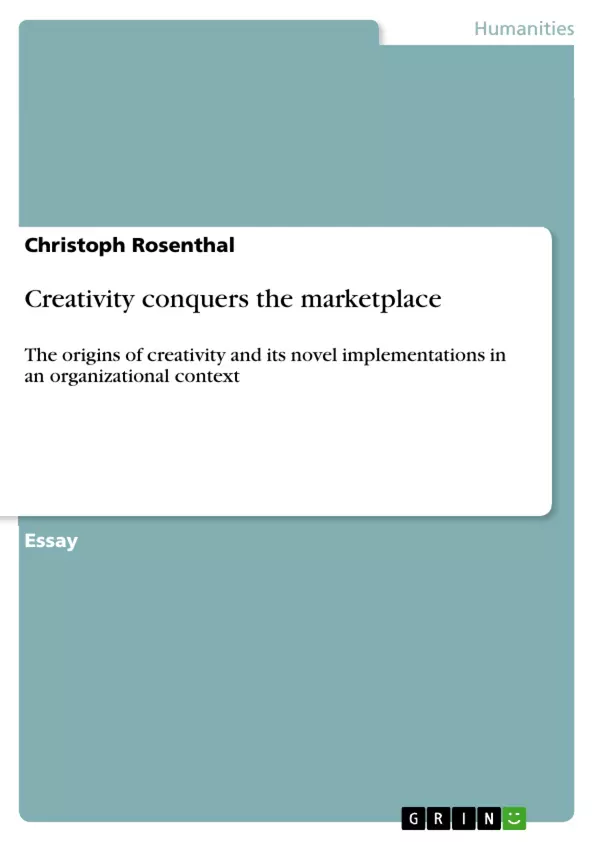Leadbeater’s (2000) metaphor of “a new economy living on thin air” gives a good idea of how to conceive of the knowledge economy. Creativity is an essential feature of the knowledge economy and has transferred from being characteristic for particular niche industries to an overarching, critical, and peculiar feature of various sectors (Pratt & Jeffcutt, 2009). Organizations have been trying to find management solutions and entrepreneurial approaches to fruitfully implement creativity and balance the innate tensions between creativity, control, and organizational structure. The essay at hand provides solutions to this dilemma and identifies starting points for implementing key characteristics and management strategies of creative organizations into creatively managing non-creative organizations. The subject matter will be discussed along the lines of the following set of interrelated questions.
• What exactly is creativity, where does it come from and what is its significance in an organizational management context?
• What constitutes creative organizations and where does innovation fit in?
• To what extend has creativity forged new forms of organizations or has been beneficially implemented by technically non-creative organizations?
• What are some innovative and collaborative approaches by organizations to take advantage of the collective nature of the knowledge economy?
Inhaltsverzeichnis (Table of Contents)
- Creative Economy and Creative Organizations Introduction
- Questions
- Approach
- What is creativity? What is innovation?
- The origins of creativity: Lone genius versus motley crew
- The origins of creativity and its organizational relevance
- Innovation and innovative organizations
Zielsetzung und Themenschwerpunkte (Objectives and Key Themes)
This essay explores the nature and significance of creativity in organizational management. It delves into the different schools of thought regarding the origins of creativity, contrasting the "heroic model" of individual genius with the "structural model" emphasizing collaborative efforts. The essay also examines the characteristics of creative organizations and analyzes how the implementation of these attributes has influenced business models and approaches. Through exemplary case studies, the essay seeks to understand the relationship between creativity, innovation, and organizational success.
- The definition and differentiation of creativity and innovation in an organizational context.
- The contrasting origins of creativity, including the "heroic model" of individual genius and the "structural model" of collaborative creativity.
- The characteristics of creative organizations and their impact on business models and approaches.
- The relationship between creativity, innovation, and organizational success.
- The role of collective creativity and collaboration in the modern knowledge economy.
Zusammenfassung der Kapitel (Chapter Summaries)
The essay begins by defining creativity as the generation of new ideas and innovation as the economic exploitation of those ideas. It highlights the blurring line between creativity and innovation in the context of modern organizations.
The origins of creativity are then explored, contrasting the "heroic model" emphasizing individual genius with the "structural model" highlighting collaborative creativity. Evidence is presented to support the value of collective creativity and the limitations of solely relying on individual talent.
The essay then examines the characteristics of creative organizations, arguing that their focus on generating new ideas and fostering collaboration often leads to financial sustainability challenges. It discusses the inherent conflict between creativity and innovation and the need for managerial approaches that effectively manage both.
Finally, the essay explores the role of innovation in organizations, emphasizing the dependence of innovative organizations on creative ones. It highlights the importance of distinguishing between creativity and innovation and understanding their interconnected nature.
Schlüsselwörter (Keywords)
This text explores the significance of creativity and innovation in organizational management, focusing on the origins of creativity, the characteristics of creative organizations, and the relationship between creativity, innovation, and organizational success. Key concepts explored include the "heroic model" and "structural model" of creativity, collective creativity, collaborative networks, and the economic exploitation of creative ideas. Additionally, the text delves into the challenges and opportunities of managing creativity within organizations, particularly in relation to organizational structure and financial sustainability.
- Citation du texte
- Christoph Rosenthal (Auteur), 2011, Creativity conquers the marketplace, Munich, GRIN Verlag, https://www.grin.com/document/269855



